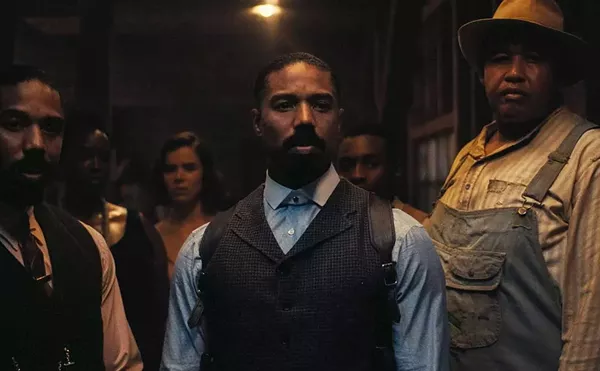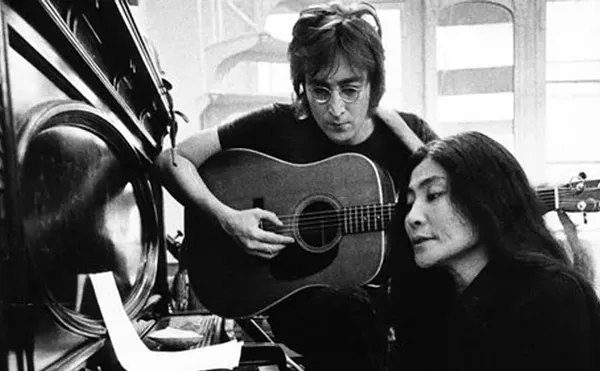
Audio By Carbonatix
[
{
"name": "GPT - Leaderboard - Inline - Content",
"component": "35519556",
"insertPoint": "5th",
"startingPoint": "3",
"requiredCountToDisplay": "3",
"maxInsertions": 100,
"adList": [
{
"adPreset": "LeaderboardInline"
}
]
}
]
A cathedral’s colossal and sooty twin towers stand guard over Mexico City. Somewhere below and just beyond their shadow, Creasy (Denzel Washington) sits across a bar table from Rayburn (Christopher Walken). Creasy, scruffy and ragged, appears like a black John the Baptist returned from the desert. But where John was said to have lived on locusts and honey, Creasy subsists on whiskey and water.
“You think God will forgive us for what we’ve done?” he asks Rayburn. The older man’s answer is succinct: “No.”
Creasy is a man attempting to drown his demons and his traumatic past in alcohol. Most writers couldn’t save a character like him from becoming a pathetic cliché. But Man on Fire’s scribe, Brian Helgeland, an Oscar nominee for Mystic River, and an Oscar winner for L.A. Confidential, isn’t most writers.
A master of subtlety, Helgeland buries clues to Creasy’s past between lines of dialogue for us to discover. Creasy and Rayburn’s unforgiven deeds remain a mystery.
But as Samuel Ramos (Marc Anthony) interviews Creasy for a job, we find that Creasy has 16 years of military experience, including some work in counter-terrorism, listed on his résumé.
The battle-scarred vet seems overqualified to bodyguard Ramos’ young daughter, Pita (Dakota Fanning). In Mexico City, though, kidnapping the rich seems the most aggressively growing sector of criminal entrepreneurship, and Creasy’s open alcoholism makes him damaged goods. Ramos hires him for a bargain-basement fee.
Creasy is a worthy addition to Washington’s rogue’s gallery of compromised heroes. At first, his eyes are wide with anxiety as if he could be caught red-handed at any moment wallowing in his secret shame and alcohol. Pita, a porcelain doll of a child, pries into his life, but Creasy makes it clear that he doesn’t want any new friends. Inevitably though, the little girl transforms him from what she calls a “big, sad bear” into something of a surrogate father. Perhaps more of a father than Samuel.
This is melodrama, of course. But Creasy isn’t the armed Mr. Bojangles to Pita’s precocious Shirley Temple. Their relationship develops a subtle and natural sweetness. It never becomes cloyingly saccharine.
As the threat of Pita’s kidnapping grows greater, director Tony Scott injects Man on Fire with increasing doses of visual adrenaline and the movie reveals itself as a thriller.
When Pita is abducted despite Creasy’s heroic efforts, Washington’s hero transforms again. He no longer tucks his head between his shoulders but walks tall, as if he’s found himself, and he leaves a trail of righteous destruction behind him. As Rayburn explains in the corniest and most uncharacteristic line of the film, “Creasy’s art is death. He’s about to paint his masterpiece.”
Scott may have managed more mayhem directing Quentin Tarantino’s screenplay True Romance, but Man on Fire’s ultraviolence makes Tarantino’s Kill Bill look like a comic book. It exceeds Travis Bickle’s notorious rampage in Taxi Driver (1976). Man on Fire would be sadistic if Creasy were a thrill killer. But while he tortures and murders, Washington’s sincere decency transfigures his character’s violent acts into justice.
Revenge thrillers seem to be the flavor of the month with the release of Walking Tall, Kill Bill and The Punisher. But as toe-curling suspense and action rear up from the tender father-daughter plot, Man on Fire succeeds as a unique oxymoron: a hard-boiled melodrama.
James Keith La Croix writes about film for Metro Times. E-mail letters@metrotimes.com.





